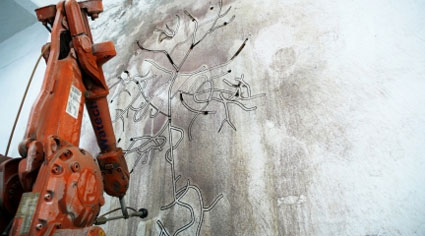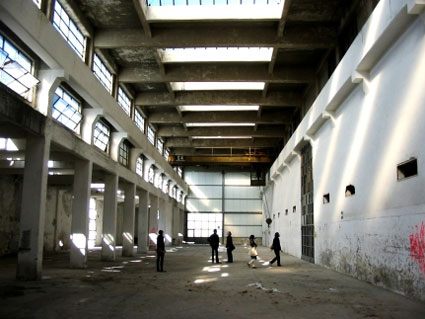
Blue Oak Ranch Reserve
Alpha Node Weather Tower
November 10 2008
Greenmeme spent a weekend at the Blue Oak Ranch Reserve with Reserve Director, Mike Hamilton.
Link



Architects Stangeland and Kropf decided to engage with this transitional state. The Naked Garden is generated by the mediation of different modes: biological propagation, mathematical abstraction and technological execution. A robot, programmed with the rules by which the fungi grow, engraves and perforates the wall already inhabited by fungi, thereby allowing light, water and wind to enter and to facilitate the basic conditions of life.

Jorge Otero-Pailos is an architect and theorist specialized in experimental forms of preservation. His contribution to Manifesta is The Ethics of Dust, an installation intended to preserve pollution and the dust that has to be swept away from the building during the renovation process. Pollution has negative connotation. Yet, it can tell fascinating stories about our social, cultural and industrial past.




But one of the main researchers – Professor David Archer of Chicago University – warns that "the climatic impacts of releasing fossil fuel carbon dioxide into the atmosphere will last longer than Stonehenge, longer than time capsules, far longer than the age of human civilisation so far. Ultimate recovery takes place on timescales of hundreds of thousands of years, a geologic longevity typically associated in public perceptions with nuclear waste."




The arts community is responding to climate change, and changing the conversation in the process.
by Natalie Jeremijenko •
Seed magazine


Elizabeth A. Thomson, News Office
September 23, 2008
MIT researchers and colleagues are working to find out whether energy from trees can power a network of sensors to prevent spreading forest fires.
What they learn also could raise the possibility of using trees as silent sentinels along the nation's borders to detect potential threats such as smuggled radioactive materials.
The U.S. Forest Service currently predicts and tracks fires with a variety of tools, including remote automated weather stations. But these stations are expensive and sparsely distributed. Additional sensors could save trees by providing better local climate data to be used in fire prediction models and earlier alerts. However, manually recharging or replacing batteries at often very hard-to-reach locations makes this impractical and costly.
The new sensor system seeks to avoid this problem by tapping into trees as a self-sustaining power supply. Each sensor is equipped with an off-the-shelf battery that can be slowly recharged using electricity generated by the tree. A single tree doesn't generate a lot of power, but over time the "trickle charge" adds up, "just like a dripping faucet can fill a bucket over time," said Shuguang Zhang, one of the researchers on the project and the associate director of MIT's Center for Biomedical Engineering (CBE).
The system produces enough electricity to allow the temperature and humidity sensors to wirelessly transmit signals four times a day, or immediately if there's a fire. Each signal hops from one sensor to another, until it reaches an existing weather station that beams the data by satellite to a forestry command center in Boise, Idaho.
Scientists have long known that trees can produce extremely small amounts of electricity. But no one knew exactly how the energy was produced or how to take advantage of the power.
In a recent issue of the Public Library of Science ONE, Zhang and MIT colleagues report the answer. "It's really a fairly simple phenomenon: An imbalance in pH between a tree and the soil it grows in," said Andreas Mershin, a postdoctoral associate at the CBE. The first author of the paper is Christopher J. Love, an MIT senior in chemistry who has been working on the project since his freshman year.
To solve the puzzle of where the voltage comes from, the team had to test a number of theories -- many of them exotic. That meant a slew of experiments that showed, among other things, that the electricity was not due to a simple electrochemical redox reaction (the type that powers the 'potato batteries' common in high school science labs, http://en.wikipedia.org/wiki/Lemon_battery). The team also ruled out the source as due to coupling to underground power lines, radio waves or other electromagnetic interference.
Testing of the wireless sensor network, which is being developed by Voltree Power (http://voltreepower.com), is slated to begin in the spring on a 10-acre plot of land provided by the Forest Service.
According to Love, who with Mershin has a financial interest in Voltree, the bioenergy harvester battery charger module and sensors are ready. "We expect that we'll need to instrument four trees per acre," he said, noting that the system is designed for easy installation by unskilled workers.
"Right now we're finalizing exactly how the wireless sensor network will be configured to use the minimum amount of power," he concluded.
The original experiments were funded by MagCap Engineering, LLC, through MIT's Undergraduate Research Opportunities Program.

Scientists offer new insight into what to protect of the world's rapidly vanishing languages, cultures, and species.
from SEED magazineThis past January, at the St. Innocent Russian Orthodox Cathedral in Anchorage, Alaska, friends and relatives gathered to bid their last farewell to Marie Smith Jones, a beloved matriarch of her community. At 89 years old, she was the last fluent speaker of the Eyak language. In May 2007 a cavalry of the Janjaweed — the notorious Sudanese militia responsible for the ongoing genocide of the indigenous people of Darfur — made its way across the border into neighboring Chad. They were hunting for 1.5 tons of confiscated ivory, worth nearly $1.5 million, locked in a storeroom in Zakouma National Park. Around the same time, a wave of mysterious frog disappearances that had been confounding herpetologists worldwide spread to the US Pacific Northwest. It was soon discovered that Batrachochytrium dendrobatidis, a deadly fungus native to southern Africa, had found its way via such routes as the overseas trade in frog's legs to Central America, South America, Australia, and now the United States. One year later, food riots broke out across the island nation of Haiti, leaving at least five people dead; as food prices soared, similar violence erupted in Mexico, Bangladesh, Egypt, Cameroon, Ivory Coast, Senegal and Ethiopia.
All these seemingly disconnected events are the symptoms, you could say, of a global epidemic of sameness.



 Augmented Ecologies , A Kinesthetic User Experience
Augmented Ecologies , A Kinesthetic User Experience
If we're serious about building a society that makes scientifically informed decisions, then science needs to figure out a way to get its message across effectively.
SEED Magazine by Chris Mooney • Posted May 29, 2007 04:34 PM
EMOTIONAL RESCUEClimate change is being called the "perfect moral storm," and scientists may need to throw the public a lifeline.
Finally, at long last, it has happened. As the planet continues to warm, active global warming skepticism has most decidedly become uncool.
The signs were unmistakable in early February, following the release of the policymakers' summary of the latest report from the UN Intergovernmental Panel on Climate Change. The document bluntly stated that the warming of the climate system is "unequivocal," with a nine in 10 chance that humans are causing it. A few scattered attacks on this conclusion emerged from the usual quarters—right-wing think tanks, The Wall Street Journal's editorial page, congressional crackpots like Oklahoma Sen. James Inhofe—but they were few and far between. There was nothing remotely resembling the barrage of volleys that followed the 1995 and 2001 IPCC report rollouts.
Instead, as newly empowered Democrats pledged to make carbon-emission caps a top priority, the Bush administration tried to erase its own previous stance of global warming skepticism. Two White House officials misquoted the president himself in order to suggest Bush had always acknowledged that human greenhouse-gas emissions are causing global warming. It was a lie, but one that told a deep truth about how the climate issue has evolved over the past several years.
Those concerned about preserving the planet should find these latest developments heartening. In the long run, apparently, reality does indeed prevail. Eventually—and just as with Big Tobacco's campaign to question the health risks of smoking—the active denialists and strategic doubt-generators can be driven into obscurity, if not into outright retreat. Eventually.
That's the good news.
But as I attended the annual meeting of the American Association for the Advancement of Science in San Francisco in February and listened to the climate-related discussions going on there in the wake of the IPCC report, I heard a less heartening theme being sounded as well. Despite ever-increasing scientific certainty, global warming remains a relatively low priority for the US public: Most Americans worry far more about issues like crime, taxes, war, education, and health care. And while the doubt-creation industry has gone into recession (at least for this issue), an insidious partisan divide still persists on climate change. A recent Pew survey revealed that over 50 percent more college-educated Democrats than Republicans accept that humans are to blame for rising temperatures. Without both acceptance and concern on the part of the public, politics won't move fast enough either. With each day that we fail to cut emissions, we're passing the buck to future generations. Yet we delay, delay, delay.
Ethicist Stephen Gardiner of the University of Washington-Seattle is one of many thinkers who've looked closely at the disconnect between the hard evidence of human-caused global warming and our failure to deal with the problem. He calls climate change a "perfect moral storm" because it uniquely tests our capacity to do the right thing (cut emissions). That climate change is global means we need coordination across societies that have vastly different values, priorities, and technological capabilities. That the most severe impacts won't be felt immediately means we have to sacrifice today to protect generations yet to come. And that there is still considerable uncertainty about future consequences means we can debate endlessly about how bad things are going to get. It's no surprise, then, that decades have passed without a coordinated global response that's adequate to the problem at hand.
But admitting and recognizing all of these hurdles doesn't let anyone off the hook. In fact, I've grown increasingly convinced that scientists and science defenders must realize that they are also responsible, to a significant extent, for failing to communicate the nature of this "perfect problem" to the rest of the public in a way that truly mobilizes action.
http://www.seedmagazine.com/news/2007/05/emotional_rescue.php